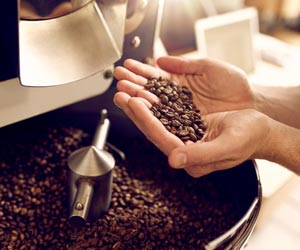Coffee Roaster
How many cups of coffee do you drink each day? Do you rely on coffee’s caffeine boost? Did you know that the world’s population drinks approximately 500 billion cups of coffee each year? Coffee is the second most traded commodity on earth (oil is the first). In the US alone, the coffee market accounts for $30-32 billion dollars annually. Coffee is big business.
One cool coffee niche job is that of a coffee roaster. Coffee roasters take green coffee beans and turn them into the beans you buy off the shelf. Coffee roasting is complex. The process directly affects the taste of the coffee you consume. Let’s look at the roasting process to give you a better understanding of what a coffee roaster does.
Coffee beans grow in the “Bean Belt”- an area between the Tropic of Cancer and the Tropic of Capricorn. The coffee growing process employs 25 million people in 50 countries in this region. The coffee beans are actually seeds inside red berries. The berries are picked, dried, and stripped. The remains are a green coffee bean.
Those green coffee beans are usually packaged into a burlap sack and shipped in bulk to coffee importers. Those coffee importers sell beans from all over the world to coffee roasters. Coffee roasters select the specific type of bean they want based on a variety of factors like soil, altitude, climate, location, elevation, and more – each factor affects the taste. Coffee roasters buy the beans in bulk and get ready to roast them.
Coffee roasters use large drum or hot air coffee roasters from brands like Diedrich or Primo. The beans are roasted at temperatures around 500 degrees F. The beans will pop, double in size, then pop again. The roasting process changes the chemical and physical properties of a green coffee bean creating the final flavor that you will enjoy. There are all types of roasts – light, medium, dark. Typically, the darker the roast, the stronger the flavor.
During the roasting process, coffee roasters weigh beans in scale hoppers, time roasting processes, adjust temperatures, monitor cooling processes, and taste lots of coffee. The process is like a recipe. It is unique for each type of coffee and may be a closely guarded secret amongst coffee brands. It is called the roast profile. The roast profile is based on temperatures and time and can be easily visualized in a graph format. There are other variables too such as the coffee’s origin, variety, and size of batch. The ability to duplicate the roast profile for each roast is what gives a coffee brand a consistent taste, product, and reputation.
Once the coffee is roasted, the coffee roaster packages and labels the coffee beans so they are ready to sell to restaurants, grocers, coffee shops, and individuals. Usually the coffee is sold near where it is roasted to increase its shelf life and to make sure it’s enjoyed while fresh.
Coffee roasters usually work for themselves as entrepreneurs or for larger coffee companies. It seems like every small town has a dedicated coffee roaster roasting a local coffee blend. Most coffee roasters learn the trade at home. Some go on to earn a roasting certification from the Roaster’s Guild. A qualified and talented coffee roaster makes an average of $14 per hour or $47,000 per year. What you earn depends on how delicious your coffee tastes.
Coffee roasters enjoy selecting beans, creating taste and roast profiles, and selling coffee. The challenge is to ensure that each batch has a consistent roast and flavor. It takes practice, attention to detail, and incredible taste buds to be a great coffee roaster. Coffee roasters have a cool job. It’s an ideal career choice for any coffee lover.
Quick Facts About Coffee Roasters
Job Title: Coffee Roaster
Office: Roasting shop
Description: Select coffee beans, create roast profiles, and roast coffee
Certifications/Education: Roasting experience
Necessary Skills: Attention to detail, Highly trained taste buds
Potential Employers: Self Employed, Coffee Companies
Pay: $14 per hour or $47,000 per year


